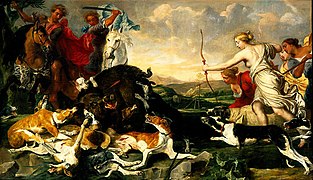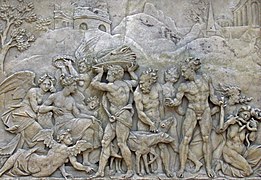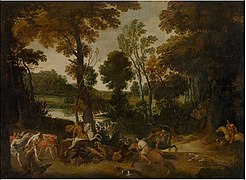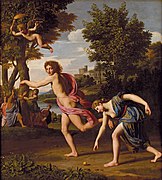Atalanta

Atalanta (/ˌætəˈlæntə/; Greek: Ἀταλάντη Atalantē) meaning "equal in weight", is a heroine in Greek mythology.
There are two versions of the huntress Atalanta: one from Arcadia,[1] whose parents were Iasus and Clymene[2][3] and who is primarily known from the tales of the Calydonian boar hunt and the Argonauts;[4] and the other from Boeotia, who is the daughter of King Schoeneus[5][6] and is primarily noted for her skill in the footrace.[5] In both versions, Atalanta was a local figure allied to the goddess Artemis;[7] in such oral traditions, minor characters were often assigned different names, resulting in minor regional variations.[8]
Early life[]
At birth, Atalanta was taken to Mount Parthenion to be exposed because her father had desired a son.[3] A she-bear—one of the symbols of Artemis—whose cubs had been recently killed by hunters came upon Atalanta and nursed her until those same hunters discovered her and raised her themselves in the mountains.[1] Atalanta then grew up to be a swift-footed virgin who eschewed men and devoted herself to the huntress Artemis.[3]
Atalanta modelled herself after Artemis, wearing a simple sleeveless tunic that reached her knees and living in the wilderness.[1][2] While living in the wild, Atalanta slew two centaurs, Rhoecus and Hylaios, with her bow after her beauty caught their attention and they attempted to rape her.[1][2][3]
The voyage of the Argonauts[]

Atalanta is only occasionally mentioned in the legend of the Argonauts;[8][9] however, her participation is noted in Pseudo-Apollodorus's account, which says that during the search for the Golden Fleece, Atalanta, who was invited and invoked the protection of Artemis, sailed with the Argonauts as the only woman among them.[10] In account, Atalanta is not only noted to have sailed with the Argonauts but to have fought alongside them at the battle in Colchis, where she, Jason, Laertes, and the sons of Thesipae were wounded and later healed by Medea.[11] In the account of Apollonius of Rhodes, Jason prevents Atalanta from joining not because she lacks skill but because as a woman she has the potential to cause strife between men on the ship.[12]
After the death of King Pelias in Iolcus, funeral games were held in which Atalanta defeated Peleus in a wrestling match.[3] This match became a popular subject in Greek art.[7]
The Calydonian boar hunt[]
In an annual celebration, King Oeneus of Calydon had forgotten to honour Artemis with a sacrifice in his rites to the gods.[4][2] In anger, she sent the Calydonian boar, a monstrous wild boar that ravaged the land, cattle, and people, and prevented the crops from being sown.[4][13] Atalanta was called upon to join Meleager, Theseus, Pollux, Telamon, Peleus, and all those who were part of the Argonaut expedition on the hunt for the boar.[4][6] Many of the men were angry that a woman was joining them, but Meleager, though having a family of his own, convinced them otherwise as he desired to father a child with Atalanta after hearing of her expertise in archery and beauty while hunting.[4][2][14]
During the hunt Hyleus and Ancaeus were killed, Peleus accidentally injured a fellow hunter and others were wounded. Atalanta drew first blood on the boar with her bow.[4] After this feat, killing the boar became a collective effort as, after the initial blow, Amphiaraus shot the boar's eye and Meleager ended its life.[4] Meleager awarded the hide to Atalanta for her valour,[6][15] but it was taken away by Meleager's uncles, Plexippus and Toxeus, who considered it dishonourable for a woman to hold such a prize.[4] In response, Meleager killed his uncles.[4] Althaea, Meleager's mother, became grief-stricken after hearing of her brothers’ deaths and threw the log that was tied to her son's life into a fire, killing him.[4][6]
Footrace[]

According to Ovid, before her adventures, Atalanta had consulted an oracle who prophesied that marriage would be her undoing. As a result, she chose to live in the wilderness.[16] After the Calydonian boar hunt, Atalanta was discovered by her father, who accepted her as his daughter and began to arrange a marriage for her.[3] To prevent this, she agreed to marry only if a suitor could outrun her in a footrace, which swift-footed Atalanta knew was impossible.[5][note 1] If the suitor was unsuccessful, he would be killed.[3][6] Her father agreed to the terms, and many suitors died in the attempt until Hippomenes,[5][16][note 2] who fell in love with Atalanta at first sight.[3] Hippomenes knew he could not best Atalanta even with the advantage of a head start, so, he prayed to the goddess Aphrodite for assistance.[5] Aphrodite, who felt spurned because Atalanta was a devotee of Artemis and rejected love, gave Hippomenes three irresistible golden apples.[3][16] As the race began, Atalanta, wearing armour and carrying weapons, quickly passed Hippomenes, but she was diverted off the path as he tossed an apple for her to retrieve;[6] each time Atalanta caught up with Hippomenes, he would toss another apple,[16] ultimately winning the race and Atalanta herself.[5][3]
Atalanta bore a son, Parthenopaios (who may have been fathered by Meleager or Ares), who became one of the Seven against Thebes.[3][18][19]
Metamorphoses into lions[]

After the footrace, Hippomenes had forgotten to thank Aphrodite for her aid, and while the couple were out hunting the goddess afflicted them with sexual passion so that they had sex in a sanctuary belonging to either Zeus[6] or Rhea.[16] They were turned into lions for their sacrilege by either Artemis (angered by Atalanta losing her virginity), the goddess Cybele, or Zeus himself.[3] The belief at the time was that lions could not mate with their own species, only with leopards; therefore Atalanta and Hippomenes would never be able to have “intercourse of love”.[6][9]
However, this view has been criticized. In her book The Amazons: Lives and Legends of Warrior Women across the Ancient World, Adrienne Mayor argues there is no evidence to support the notion that the Ancient Greeks believed male and female lions could not engage in sexual intercourse. Rather, Mayor contends the transformation of Atalanta and her lover into lions occurred at a moment of emotional and sexual bliss, which can be interpreted as divine sympathy for a couple who defied traditional Greek gender roles, and thus turning them into lions enabled the lovers to hunt and mate together for all eternity outside of Greek society which would not have accepted their relationship.[20]
Gallery[]

Oil painting of Atalanta and Meleager hunting the Calydonian boar (Jan Fyt, 1648). The Ringling, Bequest of John Ringling, 1936.

Meleager presenting Atalante the head of the Calydonian Boar in 16th century alabaster, Bode Museum.

Landscape painting of the hunt. Jan Wildens, 17th century.

Meleager et Atalanta, from a drawing by Giulio Romano, engraved by François Louis Lonsing. Atalanta is at far left with bow; Meleager is right of her, spearing the Calydonian boar (1773).

Meleager Presenting the Head of the Caledonian Boar to Atalanta at the Temple of Artemis. M. Maurice Stora (1530–1535).

Atalanta and Meleager hunting the Calydonian boar. Woodcut by Giovanni Battista Palumba, print in the British Museum.

Meleager and Atalante. Jacob Jordaens (1620–1650), Museo Nacional del Prado.

The Race between Atalanta and Hippomenes. Nicolas Colombel (1644–1717), Liechtenstein Museum, Vienna.
Notes[]
References[]
- ^ Jump up to: a b c d "Aelian: Various Histories. Book XIII, Ch. 1". penelope.uchicago.edu. Retrieved 2021-03-08.
- ^ Jump up to: a b c d e "CALLIMACHUS, HYMNS 1-3 - Theoi Classical Texts Library, HYMN 3". www.theoi.com. Retrieved 2021-03-08.
- ^ Jump up to: a b c d e f g h i j k l m "APOLLODORUS, THE LIBRARY BOOK 3.9.2 - Theoi Classical Texts Library". www.theoi.com. Retrieved 2021-03-08.
- ^ Jump up to: a b c d e f g h i j "APOLLODORUS, THE LIBRARY BOOK 1.8.2-3, Theoi Classical Texts Library". www.theoi.com. Retrieved 2021-03-08.
- ^ Jump up to: a b c d e f "HESIOD, CATALOGUES OF WOMEN FRAGMENTS, FRAGMENT 14 - Theoi Classical Texts Library". www.theoi.com. Retrieved 2021-03-08.
- ^ Jump up to: a b c d e f g h i "Hyginus, Fabulae. 173-174 and 185". topostext.org. Retrieved 2021-03-08.
- ^ Jump up to: a b Boardman, John (1983). "Atalanta". Art Institute of Chicago Museum Studies. 10: 3–19. doi:10.2307/4104327. ISSN 0069-3235.
- ^ Jump up to: a b Howell, Reet A.; Howell, Maxwell L. (1989). "The Atalanta Legend in Art and Literature". Journal of Sport History. 16 (2): 127–139. ISSN 0094-1700.
- ^ Jump up to: a b Barringer, Judith M. (1996). "Atalanta as Model: The Hunter and the Hunted". Classical Antiquity. 15 (1): 48–76. doi:10.2307/25011031. ISSN 0278-6656.
- ^ "Apollodorus, Library, book 1, chapter 9, section 16". www.perseus.tufts.edu. Retrieved 2021-03-09.
- ^ "DIODORUS SICULUS, LIBRARY OF HISTORY BOOK 4.48.5 - Theoi Classical Texts Library". www.theoi.com. Retrieved 2021-03-08.
- ^ "APOLLONIUS RHODIUS, ARGONAUTICA BOOK 1.768 - Theoi Classical Texts Library". www.theoi.com. Retrieved 2021-03-08.
- ^ "PHILOSTRATUS THE YOUNGER, IMAGINES 13 - Theoi Classical Texts Library". www.theoi.com. Retrieved 2021-03-08.
- ^ "OVID, METAMORPHOSES 8.300 - Theoi Classical Texts Library". www.theoi.com. Retrieved 2021-03-08.
- ^ "Pausanias, Description of Greece, Arcadia, chapter 45, section 2". www.perseus.tufts.edu. Retrieved 2021-03-08.
- ^ Jump up to: a b c d e "OVID, METAMORPHOSES 10.560-681 - Theoi Classical Texts Library". www.theoi.com. Retrieved 2021-03-08.
- ^ "Pausanias, Description of Greece, Elis 1, chapter 19, section 2". www.perseus.tufts.edu. Retrieved 2021-03-13.
- ^ "AESCHYLUS, SEVEN AGAINST THEBES, 526 - Theoi Classical Texts Library". www.theoi.com. Retrieved 2021-03-08.
- ^ "DIODORUS SICULUS, LIBRARY OF HISTORY BOOK 4.65-7 - Theoi Classical Texts Library". www.theoi.com. Retrieved 2021-03-08.
- ^ "PROLOGUE:", The Amazons, Princeton University Press, pp. 1–14, 2014-09-22, ISBN 978-1-4008-6513-0, retrieved 2021-07-21
Sources[]
- Aeschylus, Prometheus Bound, Suppliants, Seven Against Thebes. Translation by Vellacott, P. The Penguin Classics. London. Penguin Books
- Apollodorus, The Library of Greek Mythology. Translation by Aldrich, Keith. Lawrence, Kansas: Coronado Press, 1975.
- Apollodorus, The Library. English Translation by Sir James George Frazer, F.B.A., F.R.S. in 2 Volumes. Cambridge, MA, Harvard University Press; London, William Heinemann Ltd. 1921. Includes Frazer's notes.
- Apollonius Rhodius, Argonautica. Translation by Rieu, E. V. The Penguin Classics. London: Penguin Books.
- Barringer, Judith M. "Atalanta as Model: The Hunter and the Hunted." Classical Antiquity 15, no. 1 (1996): 48–76. Accessed March 8, 2021. doi:10.2307/25011031. https://www.jstor.org/stable/25011031
- Boardman, John. "Atalanta." Art Institute of Chicago Museum Studies 10 (1983): 3-19. Accessed March 8, 2021. doi:10.2307/4104327. https://www.jstor.org/stable/4104327
- Callimachus, Hymns & Epigrams. Translation by Mair, A. W. & Mair, G. R. Loeb Classical Library Volume 129. Cambridge, Massachusetts: Harvard University Press.
- Diodorus Siculus, Library of History. Translation by Oldfather, C. H. Loeb Classical Library Volumes 303, 377. Cambridge, Massachusetts : Harvard University Press.
- Hesiod, The Homeric Hymns, Translation by Evelyn-White, H. G. Loeb Classical Library Vol 57. Cambridge, Massachusetts: Harvard University Press.
- Howell, Reet A., and Maxwell L. Howell. "The Atalanta Legend in Art and Literature." Journal of Sport History 16, no. 2 (1989): 127–39. Accessed March 8, 2021.https://www.jstor.org/stable/43609443
- Hyginus, Fabulae from The Myths of Hyginus, translated and edited by Mary Grant. University of Kansas Publications in Humanistic Studies, no. 34. https://topostext.org/work/206
- Pausanias. Description of Greece. English Translation by W.H.S. Jones, Litt.D., and H.A. Ormerod, M.A., in 4 Volumes. Cambridge, MA, Harvard University Press; London, William Heinemann Ltd. 1918.
- Philostratus Elder, Philostratus Younger, Callistratus. Translation by Fairbanks, A. Loeb Classical Library Vol 256. Cambridge, Massachusetts: Harvard University Press.
- Aelian: Various Histories. Book XIII. Translated by Thomas Stanley, http://penelope.uchicago.edu/aelian/varhist13.html
- Ovid, Metamorphoses. Translation by Melville, A. D
External links[]
- Atalanta - World History Encyclopedia
- Theoi Project, Atalanta, a summary of Atalanta.
- Classical sculpture head of either Hygieia or Atalanta, a replica from the Louvre.
- Atalanta and Hippomenes art collection, National Museum of Scotland.
Further reading[]
- Jean Shinoda Bolen, Artemis: The Indomitable Spirit in Everywoman, Conari Press, 2014.
- Margaretta Salinger, (1944). Rubens's Atalanta and Meleager. The Metropolitan Museum of Art Bulletin, 3(1), 8-13. doi:10.2307/3257236. https://www.jstor.org/stable/3257236
- C. A. Faraone, (1990). "Aphrodite's ΚΕΣΤΟΣ and Apples for Atalanta: Aphrodisiacs in Early Greek Myth and Ritual". Phoenix, 44(3), 219–243. doi:10.2307/1088934. https://www.jstor.org/stable/1088934
- Richard Mathews, "Heart's Love and Heart's Division: The Quest for Unity in 'Atalanta in Calydon'." Victorian Poetry 9, no. 1/2 (1971): 35–48. https://www.jstor.org/stable/40001587
- Heather Reid (2020) Plato on women in sport, Journal of the Philosophy of Sport, 47:3, 344–361. https://doi.org/10.1080/00948705.2020.1811713
| Wikimedia Commons has media related to Atalanta. |
- Greek mythological heroes
- Argonauts
- Women of Ares
- Women in Greek mythology
- Metamorphoses characters
- Characters in Greek mythology
- Deeds of Zeus
- Arcadian mythology
- Boeotian mythology








